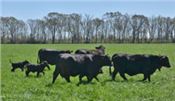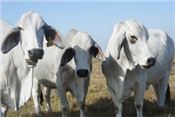|
Biosecurity Practices Key To Safe Animal Agriculture During Spring And Beyond
BATON ROUGE, LA.
For decades, producers of beef cattle, dairy animals, hogs and poultry have taken steps to safeguard their herds and flocks from biological risks like diseases and pests – and from spreading them to other farms and ranches. Biosecurity strategies and management practices are key to warding off threats and maintaining a safe animal food supply.
“The current human pandemic reminds us that biosecurity in animal ag operations is always important to protect animal herds and flocks from animal diseases we already have in the U. S. and from foreign animal diseases,” said Dr. Christine Navarre, LSU AgCenter veterinarian.
According to the U.S. Department of Agriculture Animal and Plant Health Inspection Service, some of the greatest risks to herd health include illegal agricultural imports from other countries, bringing new animals onto your premises, farm visitors and shared farm equipment that has been in contact with livestock or manure.
“During the spring season, when farmers are helping other farmers at different operations, there are a number of important best practices to follow,” said AgCenter regional livestock specialist Jason Holmes.
Biosecurity measures he suggests include:
• Keep animals that are new to the farm in a separate “quarantine” area for an established amount of time (at least 30 days) to monitor the health status of the new animals.
• Take steps to prevent disease, such as vaccinating new cattle that aren’t up-to-date on their shots.
• Clean and disinfect tattoo pliers, ear tagging pliers, dehorners and ear notchers after daily use with a 1 to 1 bleach to water mix.
• Clean repeater syringes with regular hand soap and hot distilled water. Do not use bleach or other disinfectants. Then, boil distilled water, suck up the boiling water and push it out of the syringe three times.
• Scrub off any visible dirt and disinfect your boots before returning to your farm from helping a neighbor. And consider disposable booties when visiting high-risk areas.
• Keep visitor vehicles out of areas that are accessible to livestock.
“Each producer should contact their own veterinarians to determine what practices work best for their particular herds,” Navarre said.
It’s also important to prepare now for disasters of any kind, which can spread biological threats.
“Cattle that are sheltered in place or evacuated will be stressed and may be commingled with other cattle, so herd biosecurity may be breached,” Navarre said. “Ranchers should keep good records and develop a good disaster preparedness checklist.”
“The ranch veterinarian can help with biosecurity concerns and movement papers if necessary,” she added.
Navarre has created a guide “Natural Disaster Planning for Beef Cattle Ranches,” which can be found online at https://bit.ly/cattledisasters.
The USDA encourages animal agriculture producers to be aware of diseases that concern their herd or flock and to look out for unusual signs or behavior because early detection is important to preventing the spread of disease.
Producers can report serious or unusual animal health problems to their veterinarians, local extension offices, or state or federal animal health officials. The USDA also operates a toll-free hotline at 866-536-7593 to assist them. ∆

Black Angus cows and their calves at the LSU AgCenter Iberia Research Station near Jeanerette.
File photo by Bruce Schultz/LSU AgCenter.

Brahman cattle at the Watkins Ranch in Jefferson Davis Parish.
File photo by Bruce Schultz/LSU AgCenter.
|
|